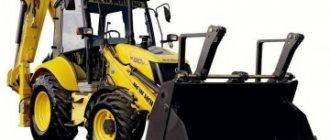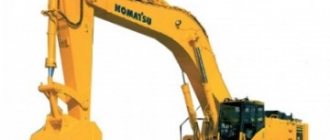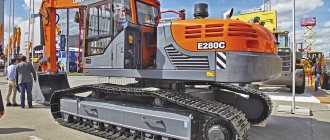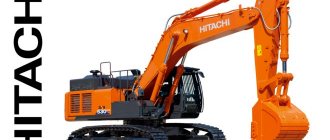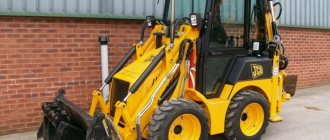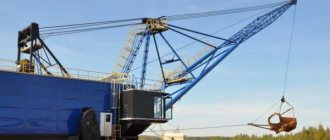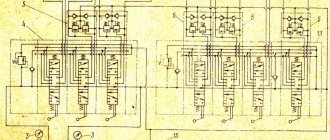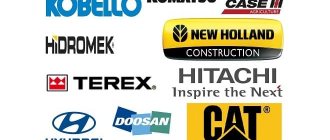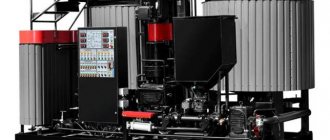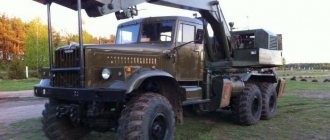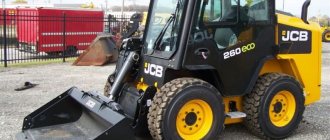Time for mechanical excavators. Review of Kostroma EZ equipment
Read
180 years since the founding of Volvo CE
Undoubtedly, evolution does not stand still, and hydraulic excavators are rapidly replacing mechanical excavators from construction sites. But there are jobs or regions of use where the use of hydraulic technology is impossible or irrational - these are pile-driving machines or when working in industrial quarries, as well as under extreme temperature conditions, where hydraulic technology is weak and powerless. Thanks to this, cable (cable) excavators continue to be produced, such as EO-5119 or EO-4112A.
Photo source: techstory.ru
The history of the plant began in 1915, when the plant of the heirs of L.F. was evacuated from Riga to Kostroma. Plo, who made tools, files, fans and much other equipment. Excavator construction at the plant began in 1933, when the first steam excavator was produced. In 1937, the production of electric and diesel excavators was mastered, and in April 1939, a prototype of Europe's first walking excavator walked out of the assembly shop gate with two-meter strides. He was sent to one of the construction sites in the North. During these years, huge production reserves were discovered and put into action. During the Second World War, the production of excavators was suspended. In a short time, a large complex of organizational and technical measures was completed and the production of the most important defense products was successfully mastered. Excavator production resumed only in 1944. By 1948, the plant finally specialized in the production of mechanical rope excavators. Excavators were supplied from Kostroma to all former Soviet republics, as well as to 43 countries around the world. At one time, the plant produced the following models of excavators.
Photo source: techstory.ru
Look
History in photographs. What was technology like in the middle of the last century?
The E-801 excavator with a bucket capacity of 0.8 m3 is designed for work in quarries and construction sites in soils up to category IV and finely crushed construction soils of categories V and VI. The E-801 excavator replaced the obsolete E-753 and E-754 excavators, which had been discontinued since 1956. The E-10011A excavator with a bucket with a capacity of 1.0 m3 can work with a front and back shovel, a dragline and a grab. The length of the main lattice boom is 12.5 m. When working with crane equipment, the lattice boom can be extended to 25 m. The E-10011AS excavator is a modification of the E-10011A excavator and is designed for work in the northern regions. Critical parts of the excavator are made of high-quality steel, additionally heat-treated. To start the engine, a pre-heater is installed. The turntable is mounted on a roller slewing ring. The driver's cabin is insulated and heated by a heating and ventilation unit. The pneumatic control system includes an alcohol dryer and an additional oil and water separator. The excavator's electrical equipment has a more powerful alternator; Electrical devices are installed to monitor the operation of the engine and torque converter.
Photo source: techstory.ru
The E-10011D excavator is a single-bucket universal excavator with a mechanical drive on crawler tracks and is the fifth modernization of the E-10011A excavator. Replaceable equipment with which the excavator worked - a forward and reverse shovel, a dragline, a grab, a crane, and pile-driving equipment. The control of the actuators is pneumatic. a turbotransformer is used to drive the mechanisms (in some sources this is what this mechanism is called, the exact name is a torque converter), which protected the engine and transmission from sudden loads and overloads that arose during operation, creating the best power and speed modes of operation . The modernized E-10011E excavator became the last in the model range of these machines. In 1982, a prototype of the modernized EO-5111B excavator passed acceptance tests and was recommended for mass production.
Look
All advertisements for the sale of excavators
The EO-5111B excavator is designed to perform excavation work in soils of categories I - IV and finely crushed rocks, loading and unloading and installation work in industrial and civil construction at air temperatures from -40 to +40°C. The excavator consists of a running multi-support tracked device, a rotating platform with mechanisms, a body and a driver’s cabin and interchangeable working equipment: a front and back shovel, a dragline, a grab and a crane.
Photo source: techstory.ru
The full-rotary excavator EO-5112A (EP-1A) is designed for cleaning and loading blasted rock with pieces up to 800 mm in size in mines in which mining is carried out using chamber methods, as well as for the development of blasted rock on the surface. Rock can be loaded into dump trucks and self-propelled trolleys with a maximum bucket unloading height of up to 5 m. The excavator can operate in mine chambers with a height of at least 6 m and a width of at least 10 m.
Recently, EKSKO OJSC has been producing universal cable-type excavators, model EO-5119, on crawler tracks with various types of replaceable working equipment.
The figure shows the kinematic diagram No. 1 of the Kostroma EZ excavators
The figure shows kinematic diagram No. 2
excavators
The advantage of these excavator models is the presence of a torque converter . Torque from the engine to the mechanisms is transmitted through a torque converter, chain gearbox and intermediate shaft. The torque converter automatically changes torque and speed depending on the load on the working part of the machine. Torque converters are used in combination with the mechanical part of the transmission, which provides high efficiency. transmissions in various operating modes. Torque converter U 35801... (manufactured by the Kalinin Moscow Machine-Building Plant) is designed to automatically change torque and rotation speed in the drive of construction and road vehicles.
Technical characteristics of the torque converter:
| The name of indicators | Meaning | |
| U358011E | U358018D | |
| Active diameter | 325 +/- 3 | 530+/- 3 |
| Power, kW (l/s) | 50+/- 2,6 (68+/-3,5) | 73,5+/-2,2 (100+/-3) |
| Nominal rotation speed of the input link, l, nom, min. (rpm) | 30(1800) | 17,5 (1050) |
| Maximum total efficiency, %, not less | 84 | 87 |
| Torque transformation ratio in stop mode | 2,6+/0,1 | 2,7+/- 0,1 |
| Overall dimensions, mm Length Width Height | 715 580 620 | 825 990 900 |
| Weight (without working fluid), kg | 157 | 455 |
| Supply system | ||
| Gear pump: type | NSh 50U-2 | |
| Nominal volumetric supply of working fluid, l/m | 50 | 75 |
| Discharge pressure at the inlet to the torque converter, MPa (kgf/cm) | 0,04-0,15 (0,4-1,5) | 0,06-0,2 (0,6-2,0) |
| Nominal safety valve setting pressure, MPa (kgf/cm) | — | 0,8 (8) |
| Control system | ||
| Spool | Two-position with pneumatic control | |
| Minimum air injection pressure, MPa (kgf/cm) | 0,4 (4) | |
Notes:
- Maximum overall efficiency power ratings and transformation ratio are indicated for working fluid with a viscosity of 4 to 6 mm2/s (cSt) and a density of 825 to 840 kg/m.
- Power stated at maximum overall efficiency. and the nominal rotation speed of the torque converter input link.
Unified compressor U43102A (manufactured by the Vilnius Association for the Production of Construction and Finishing Machines) - designed to provide compressed air to various road construction, earthmoving and other equipment (excavators, marking machines, combine maintenance units, mine electric locomotives, etc.) It can be used use on any machine or equipment driven (via a V-belt drive) by an internal combustion engine or an electric motor, which makes the machines independent of the pneumatic network and expands their capabilities. The compressor is a single-stage, two-cylinder piston compressor with forced air cooling and has an unloading mechanism that switches the compressor to idle when there is no compressed air flow. It is manufactured in three versions: 1, 2, 3 - the unified compressor U43102A is used as an independent source of compressed air, and the compressor unit SO-62A-2 is used in the manufacture of mobile compressor units SO-62A-2.
| Specifications | |||
| productivity, m3/h | 31 | ||
| compressed air pressure, kgf/cm2 | 7 | ||
| rated crankshaft rotation speed, rpm | 1300 | ||
| shaft power consumption, kW | 4,2 | ||
| Overall dimensions, mm | 440X360X555 | ||
| weight, kg | 67 | ||
| execution | 1 | 2 | 3 |
| pulley diameter | 200 | 200 | 240 |
| pulley groove profile | B | IN | B |
| direction of rotation (from the flywheel pulley side) | counterclock-wise | clockwise | |
Differential spool 07.06.400, 264.23.00
The spool is supplied in 3 versions:
| Differential spool (large textolite) d=38.5 | Differential spool (large metal) d=38.5 | Differential spool (small metal) d=33 |
All presented differential spools are interchangeable.
Differential spool - designed to turn on and off excavator mechanisms. Differential spools are installed in the columns of the control panel, the boom control mechanism, and the boom lift limiter.
Appendix 3 Characteristics of equipment - MegaLectures
| Technical characteristics of graders | Motor grader brand | Trailed grader brand | ||||
| DZ-99 (D-710B) | DZ-31-1 (D-557-1) | DZ-14 (D-395A) | DZ-98 | DZ-1 (D-20B) | ||
| Blade length | m | 3,04 | 3,7 | 3,7 | 3,7 | 3,7 |
| Blade height | « | 0,5 | 0,6 | 0,7 | 0,7 | 0,5 |
| Depth of cut | « | 0,2 | 0,25 | 0,5 | 0,5 | 0,3 |
| Turning radius | « | — | ||||
| Engine power | kW (hp) | 66 (90) | 99 (135) | 121 (165) | 184 (250) | 79 (107) |
| Grader weight | T | 9,7 | 12,40 | 17,4 | 19,5 | 4,36 |
Soil development when constructing excavations and embankments using single-bucket dragline excavators
| Index | Unit | Excavator brand | ||||||||||
| measurements | E-302, E-303, E-304 | EO-3311B, (E302B) E-304V, E-304G | E-504, E-505, E-505A | KM-602 | E-651, E-652, E-656 | E-801 | EO-5111 (E-10011), EO-5111E (E-10011E) | EO-6111 (E-1251), EO-6112B, (E-1252B) | EO-7111 (E-2503), EO-7111S, (E-2505) | |||
| Bucket capacity: | ||||||||||||
| with teeth | m | 0,35 | 0,4 | 0,5 | 0,6 | 0,65 | 0,75 | 1,5 | ||||
| with continuous cutting edge | « | 0,4 | — | 0,65-0,8 | 0,8 | 0,65-0,8 | 1,1 | — | 1,25-1,5 | — | — | — |
| Control | — | Mechanical | Pneumatic | Mechanical | Electrical | |||||||
| Boom length | m | 10,5 | 10,5 | 12,5 | 12,5 | 17,5 | 17,5 | |||||
| Largest digging radius | « | 10,1 | 11,1 | 10,2 | 13,2 | 10,2 | — | 12,9 | 27,4 | 19,5 | 19,3 | |
| Maximum digging depth: | ||||||||||||
| on a side pass | « | 4,2 | 4,42 | 3,8 | — | 3,8 | — | 5,1 | 9,3 | 9,3 | ||
| at end pass | « | 7,8 | 5,6 | 7,8 | 5,6 | 6,7 | 9,4 | 7,5 | 20,5 | |||
| Largest unloading radius | « | 8,3 | 8,3 | 10,4 | 8,3 | 9,2 | 12,2 | 10,4 | 23,8 | 16,7 | 16,7 | |
| Maximum unloading height | « | 6,3 | 5,5 | — | 5,5 | 5,5 | 6,1 | 6,5 | 15,9 | 10,5 | 10,5 | |
| Power | kW (hp) | 28 (38) | 37 (50) | 48 (65) | 59 (80) | 59-74 (80-100) | 74 (100) | 74 (100) | 85 (116) | 160 (218) | ||
| Excavator weight | T | 11,3 | 12,4 | 21,6 | 22,3 | 21,2 | 26,6 | 39,75 |
EXCAVATORS WITH MECHANICAL DRIVE
| Index | Unit | Excavator brand | |||||||||
| E0-1621 (E-153) | E-302, E 303, E-304 | E-504, E-505, E-505A | E-651, E-652, E-656 | E-801 | EO-5111A (E-10011A) | EO-6111 (E-1251), EO-6112, (E-1252) | EO-7111 (E-2503), EO-7111S (E-2505) | SE-3 | ECG-4 | ||
| Bucket capacity: | |||||||||||
| with teeth | m | 0,15 | 0,3 | 0,5 | 0,65 | 0,8-1 | 1,25 | 2,5 | 3-4 | ||
| with continuous cutting edge | « | — | 0,4 | 0,65 (0,8) | 0,65 (0,8) | 1,5 | — | 1,5 | — | — | — |
| Boom length | m | 2,3 | 5,5 | 5,5 | 5,5 | 5,5 | — | 6,8 | 8,6 | 10,5 | 10,5 |
| Largest digging radius | « | 4,1 | 5,9 | 7,9 | 7,8 | 8,6 | 9,0 | 9,9 | 14,3 | ||
| Digging radius at parking level | « | 2,4 | 4,8 | 4,7 | 2,8 | 6,3 | 7,2 | 9,2 | 8,7 | ||
| Maximum digging height | « | 1,8 | 6,2 | 6,6 | 7,1 | 7,4 | 6,7 | 7,8 | 9,5 | ||
| Largest unloading radius | « | 2,9 | 5,4 | 7,2 | 7,1 | 7,7 | 8,9 | 10,8 | 12,4 | 12,6 | |
| Maximum unloading height | « | 2,6 | 4,3 | 4,6 | 4,5 | 5,1 | 5,1 | 6,6 | 6,3 | ||
| Power | kW (hp) | 27 (38) | 28 (38) | 59-74 (80-100) | 59-74 (80-100) | 74 (100) | 74 (100) | 63-110 (85-150) | 87-160 (118-218) | — | — |
| Excavator weight | T | 5,3 | 11,3 | 20,5 | 20,5 | 27,6 | 31,5 | 39,8 |
EXCAVATORS WITH HYDRAULIC DRIVE
Technical characteristics of excavators
| Index | Unit of measurement | Excavator brand | ||
| EO-2621A | EO-4321 | EO-5122 | ||
| Bucket capacity | m | 0,25 | 0,8 | 1,6 |
| Maximum digging height | m | 4,6 | 7,9 | 9,65 |
| Largest digging radius | « | 4,7 | 7,45 | 8,93 |
| Maximum unloading height | « | 3,3 | 5,67 | 5,1 |
| Power | kW (hp) | 44 (60) | 59 (80) | 125 (170) |
| Excavator weight | T | 5,45 | 19,2 | 35,8 |
Soil development during the construction of excavations and embankments using hydraulic single-bucket excavators equipped with a backhoe
Table 1
Technical characteristics of excavators equipped with a backhoe
| Index | Unit | EO-3322A, EO-3322B, EO-3322V | EO-5015A, EO-3121B (E-5015B) | EO-4321 | EO-4121A | EO-5122 | |||
| Bucket capacity | m | 0,4 | 0,5 | 0,63 | 0,5 | 0,4 | 0,65 | 0,65; 1,25 | 1,25; 1,6 |
| Maximum digging depth | m | 4,2 | 4,3 | 4,5 | 6,7 | 5,5 | 5,8 | ||
| Largest digging radius | « | 8,2 | 7,5 | 7,6 | 7,3 | 10,16 | 8,95 | 9,4 | |
| Maximum unloading height | « | 5,2 | 4,8 | 4,7 | 3,9 | 6,18 | 5,6 | ||
| Power | kW (hp) | 59 (80) | 55 (75) | 59 (80) | 95 (130) | 125 (170) | |||
| Excavator weight | T | 14,5 | 12,7 | 19,2 | 19,2 | 35,8 |
EXCAVATORS WITH MECHANICAL DRIVE
| Index | Unit | Excavator brand | ||||||
| EO-1621, (E-153) | EO-3311 (E-302) | EO-3311G (E-302G), EO-3111A (E-303A), EO-3111V (E-303V), E-304B, E-304V | E-504, E-505 | E-651, E-652, E-656 | KM-602 | EO-5111A (E-10011, E-10011A) | ||
| Bucket capacity | ||||||||
| with teeth | m | 0,15 | 0,3 | 0,4 | 0,5 | 0,65 | 0,6 | — |
| with continuous cutting edge | « | — | 0,4 | — | 0,65-0,8 | 0,65-0,8 | 0,8 | 1,1 |
| Boom length | m | 2,3 | 4,9 | 4,9 | 5,5 | 5,5 | 13,0 | 12,5 |
| Largest cutting radius | « | 4,1 | 7,8 | 7,8 | 9,2 | 9,2 | 13,2 | |
| Maximum digging depth | ||||||||
| for trenches | « | 2,2 | 4-4,4 | 5,6 | 5,6 | 7,8 | — | |
| for pits | « | 2,2 | 2,6 | 2,6-3 | 7,8 | 6,1 | ||
| Radius of unloading into transport | « | 2,1 | 4,20 | 4,15 | 5,4 | 10,4 | 7,8 | |
| Height of unloading into transport | « | 1,7 | 2,25 | 2,7-3 | 1,7 | 2,3 | — | 5,1 |
| Power | kW (hp) | 27 (37) | 28 (38) | 37 (50) | 59 (80) | 59 (80) | 59 (80) | 59 (80) |
| Excavator weight | T | 5,3 | 11,3 | 11,6 | 20,5 | 20,5 | 22,3 | 43,2 |
Excavation of soil in pits using excavators equipped with a leveling bucket
Technical characteristics of the E-4010 excavator
| Base | KrAZ-258 or KrAZ-221 |
| Bucket - a backhoe with a continuous cutting edge, capacity, m …………………………………. | 0,4 |
| Scraper: | |
| length, m…………………………………………………………… | 2,5 |
| height, m………………………………………………………. | 0,4 — 0,45 |
| Maximum boom reach in the horizontal plane, m…………………………………………………………. | 7,38 |
| Maximum digging depth, m: | |
| without extension cord……………………………………………………………. | 3,42 |
| with extension cord…………………………………………………………….. | 4,05 |
| Maximum digging radius, m: | |
| without extension cord……………………………………………………………. | 7,38 |
| with extension cord…………………………………………………………….. | |
| Weight, t…………………………………………………………………………………. | 18,44 |
Soil development using single-bucket excavators equipped with a grab bucket
Technical characteristics of excavators equipped with a grab bucket
| Index | Unit | Excavator brands | |||||
| EO-302 | E-504, E-505 | E-651, E-652, E-656 | E-801 | E-10011D, EO-5111E (E-10011E), EO-10011AS | EO-6111 (E-1251), EO-6112 (E-1252) | ||
| Bucket capacity | m | 0,35 | 0,5 | 0,5 | 0,75 | 1, 5 | |
| Boom length | m | 10,5 | 12,5 | 12,5 | |||
| Boom angle | hail | — | |||||
| Grab radius and soil unloading | m | 8,3 | 5,2 | 12,2 | 12,3 | ||
| Maximum digging depth | « | — | — | 7,2 | |||
| Maximum unloading height | « | 7,8 | 6,7 | 5,8 | 10,7 | 3,8 | |
| Power | kW (hp) | 28 (38) | 48 (65) | 74-48 (100-65) | 74 (100) | 74 (100) | 85 (116) |
| Excavator weight | T | 11,5 | 19,7 | 21,4 | 26,8 | 39,3 |
Soil development using trench chain excavators
Recommended pages:
Use the site search:
©2015- 2022 megalektsii.ru All materials presented on the site are solely for the purpose of information for readers and do not pursue commercial purposes or copyright infringement.
megalektsii.ru
